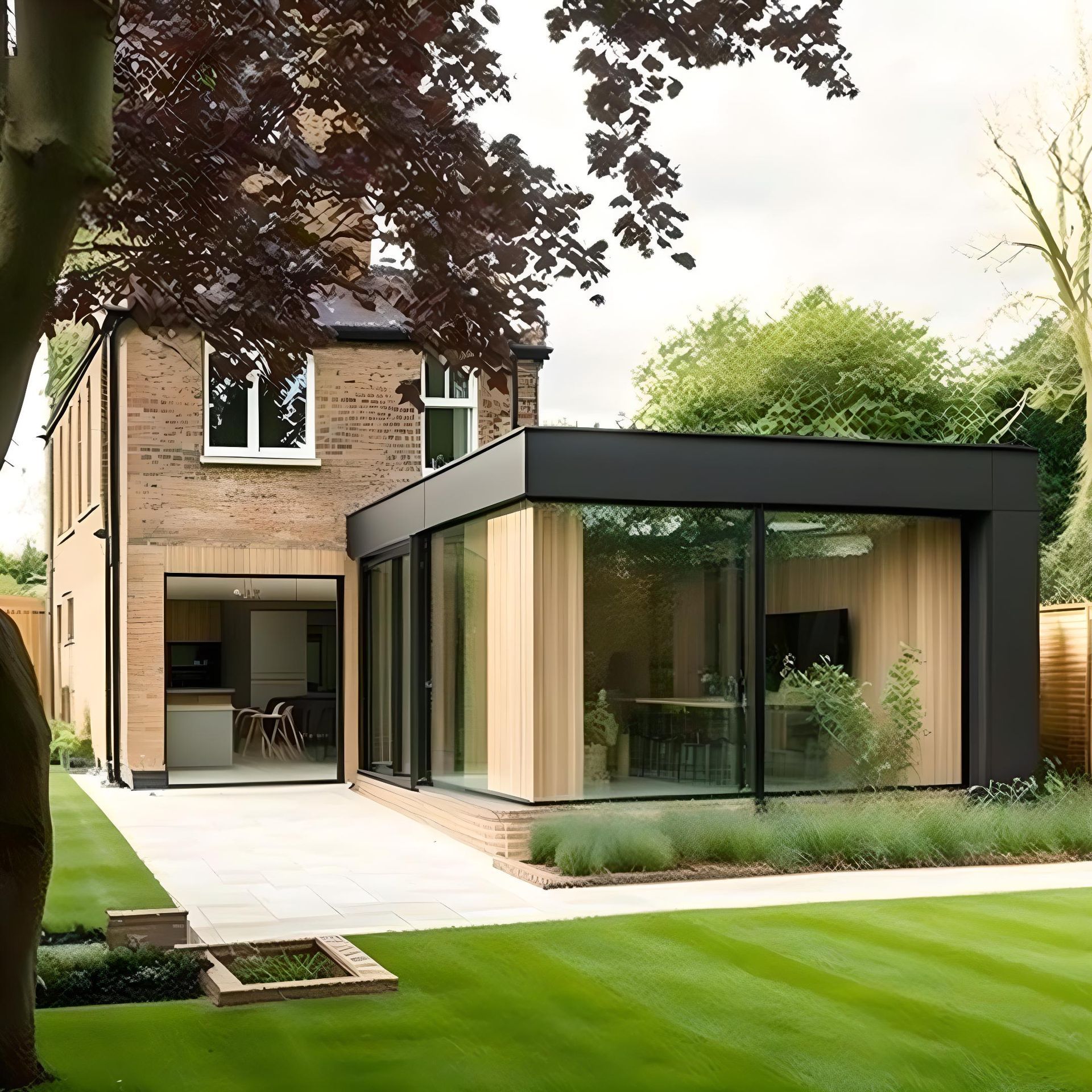Lofty Goals? A Guide to Understanding the Different Types of Loft Conversions
If you are running out of space in your home and have a loft, converting it into living accommodation is a great way of expanding. Because you already have the outer walls in place, converting the inside is usually less expensive than building an extension. If you need an extra bedroom, home office or even a bedroom with ensuite, converting the loft is the way to go. Let’s check out the types of loft conversions available, approximate costs and planning regulations.
1a. Dormer loft conversion
Popular because of its simplicity and affordability is the dormer type of loft conversion. Structurally, the extension will project out vertically from the roof slope, resulting in a box shape. There are no major changes to be made when producing this sort of conversion and the ability to use standard windows keeps the cost down.
The advantages of a dormer style loft conversion:
- Provides plenty of headroom
- Walls remain straight with flat ceilings
- Creates plenty of room internally
- Plenty of ventilation and light
- Inexpensive when compared to other types
- Should suit most types of houses in the UK
- Frequently comes under permitted development
The disadvantages of a dormer style loft conversion:
- Might not be the most aesthetically pleasing
Other variations on this theme are the L-shaped dormer, which wraps around the rear and side of the property and the gabled dormer – this has a v-shaped roof. The latter will cost more whilst reducing headroom but may be preferred for the front of a property.
1b. Mansard loft conversion
With this type of loft conversion, the party wall shared with your neighbour has to be raised. The roof will still be flat but the outer wall will slope inwards. Most mansards are located at the rear of terraced houses.
The advantages of a mansard style loft conversion:
- Felt to be more aesthetically pleasing in design than the dormer
- Looks good with older buildings
- Provides more headroom than other conversions
- Let’s plenty of light in
The disadvantages of a mansard style loft conversion:
- Planning permission will likely be required
- A party wall agreement will need to be issued
- Construction time takes longer
- More expensive than other styles of loft conversions
1c. Hip-to-gable loft conversion
For those living in detached or end-terraced homes, a hip to gable conversion of the loft will straighten the end roof, leaving a vertical wall. This opens up the space and makes it feel much larger.
The advantages of a hip-to-gable loft conversion:
- Blends well with the existing property
- To give maximum space, it can be combined with a rear dormer conversion
- Great for chalets and bungalows
The disadvantages of a hip-to-gable loft conversion:
- Cannot be used for mid-terraced properties
- Costs more than a dormer loft conversion
- If the neighbouring property doesn’t have a hip to gable, the building can look imbalanced
1d. Roof light / Velux loft conversion
If your budget is tight, how about considering a roof light loft conversion? The space will remain as it is with just windows added and the floor reinforced.
The advantages of a roof light loft conversion design:
- Can be as much as 25% less expensive than other loft conversion types
- A high approval rate in conservation areas
- The eaves area provides plenty of storage space
The disadvantages of a roof light loft conversion:
- There needs to be a minimum head height of 2.25m in the middle of the room
- The space will remain the same so additional room is not provided
- Headroom is limited
- May require planning permission if the windows are at the front
2. Establishing if your property is suitable for a loft conversion
Just because your home has a loft, this doesn’t automatically mean that it can be converted. Before you start talking to builders, it’s a good idea to contact an architectural technician and ask them to carry out a survey (which is usually free of charge).
They will visit your property and check the following:
- Roof structure – is it a modern trussed roof or a traditional one with rafters and purlins?
- Height – the minimum height required for a traditional roof is 2.2 metres and 2.4 metres for a trussed roof.
- Useable space – will the loft space provide enough useable space to make it practical?
- Chimney – ideally, the chimney does not pass through the loft so will not need to be relocated.
- Roofing felt – does your roof have felt below the tiles? If not, you will see the tiles and the wooden battens. Unless the house is very old, it should have felt.
Once the survey is completed, the architectural technician will let you know whether your loft is suitable to convert. It’s then just a matter of choosing the most suitable style of conversion to suit your budget. Should the survey throw up a problem, don’t worry as most of the time, this can be handled with a little extra work.
3. What will my loft conversion cost?
It’s very hard to give an estimate as much depends upon where you live, the type of conversion and any extras included. The most basic of loft conversions can be provided for £1700 per Sq. Metre with more elaborate and complex designs costing approximately £2000 per Sq. Metre.
4. Why convert my loft?
If you live in a property that has a loft, converting it is a great way of providing more space cost-effectively. Many homeowners find that by using space that is already available, they don’t have to spend nearly as much as when building an extension. Whether your home is old or modern, if you have a loft and are running out of space in the main living area, considering getting your loft converted makes so much sense. There are also many advantages obtained when you convert your existing loft space:
Create more space
You get more space without having to move home or build new external walls with a roof (as with an extension). The unused space in your loft is ready and waiting to be converted, providing you with all of the additional space that you need. Look at other completed loft conversions and you will see that they are regularly used as bedrooms, gyms, reading rooms, playrooms, home offices and even music rooms. Whatever you need, your loft can provide it, ensuring that your family has plenty of space to live in and move around.
Improve the residual value of your property
It’s truly a win-win situation when you convert a loft. Not only do you get the additional space you were so craving but also the value of your home will go up. In addition, the great thing is, it is usually by much more than the cost of the conversion. By getting your loft designed by experts, your home will stand out from others in the same area and will be more valuable. If you decide to move in the future, potential buyers will be attracted by the creative use of the extra space. Think of the money that you spend on the conversion as an investment rather than a cost with no return.
Take advantage of the view
Once you get up into the roof, the chances are that you will see views that you didn’t know existed! Whether you live in the city or the countryside, the extra height is sure to make the most of the surrounding landscape. When placing your windows in the converted loft, don’t forget to make the most of those stunning views. Irrespective of how you are going to use the space, taking advantage of the available views is a sure-fire way to make your property more attractive.
Some commonly asked questions about the loft conversion process:
-
How much does a loft conversion cost?
This varies depending upon so many factors, such as size, location and complexity of the design. A typical loft conversion may cost anywhere between £20,000 and £45,000 with the larger and more complicated designs coming in at £65,000. The more dormers you have, the higher the cost.
-
What types of tradesmen are required to convert a loft?
Just like converting any other part of your home, you will require an assortment of tradesmen. If you employ the services of a loft conversion company, they will usually provide all of the following so that you don’t have to manage individual contractors:
- Bricklayer: will construct walls, adding in place insulation and soundproofing.
- Glazier: will supply and fit the windows/skylights.
- Electrician: will supply and fit all electrical sockets and lighting.
- Plumber: takes care of the plumbing for bathrooms and kitchens, if included.
You should shop around for someone to convert your loft as comparing prices can save you as much as 40%.
-
What is the length of time required to complete a loft conversion?
So many factors come into play here. Much depends upon how well managed the contract is and whether you require planning permission or not. A mansard conversion is the most complex so may take up to eight weeks. For a dormer allow up to six weeks and with a roof light conversion, allow four weeks.
-
Will I need planning permission to complete my loft?
Some loft conversions fall within permitted developments so do not require planning permission. If you are not sure, contact your local authority or ask your architectural technician to do this for you. Listed buildings and those in conservation areas will always require planning permission. Where the conversion increases the roof height or affects your neighbour’s views, then the local authority will require planning permission so that they can advise your neighbours.
Get in touch
It doesn't matter how large or small your project is, or how early in the planning process you are. We can help.
With our vast experience, we deliver both a refreshingly honest approach and great value for money; after all, when it comes to projects as crucial as these, you want to get it right the first time! Our team of experienced and highly qualified architects and designers can bring your home improvement dreams to life.
Request a FREE consultation with our design team
Request your FREE no-obligation proposal

Schedule a Call/Get in Touch Form
We will get back to you as soon as possible.
Please try again later.
Related posts
Our fast and seamless design and planning services have helped thousands of homeowners maximise their living space.
H: M - F / 8am - 5.30pm
Take a Look Around
Service Areas
Social
Fast Plans | All Rights Reserved.


